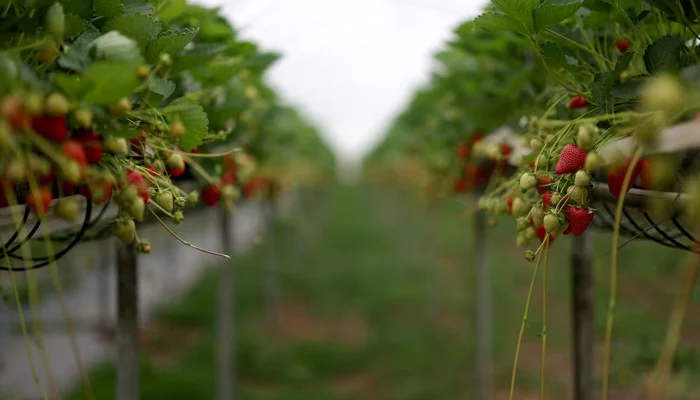British strawberry farmers are celebrating a bumper crop this year, attributing the success to record-breaking spring sunshine and consistently warm days. This has resulted in a harvest that is both larger and sweeter than usual.
James Miller from WB Chambers Farms stated that prolonged periods of sun combined with cool nights created “perfect” conditions for the strawberry harvest. Miller further explained that the dry and pleasant weather also significantly boosted insect pollination, which in turn enhances the quality and shape of the berries.
“They’re bigger and sweeter this year than we’ve seen in previous years,” said Miller, who serves as the commercial director for one of the UK’s largest berry producers. At one farm near Dartford in Kent, southeast England, rows of strawberry plants were visibly laden with the weight of gleaming red fruit, nestled within insulating polytunnels. As farmhands meticulously worked their way down the semi-circular white tunnels, punnets were filled with ripe strawberries—some astonishingly the size of small fists.
Nick Marston, chairman of British Berry Growers, an organization representing the majority of the UK’s soft fruit farms, commented that the weather has led to “super berry size and super flavour.” Marston told AFP, “I’ve been in the berry industry for 30 years and this is one of the best springs I’ve ever seen, in terms of both the weather and also the crop.”
‘Better place’
This year, Britain experienced its warmest spring in terms of mean temperatures since records began in 1884, as announced by the Met Office this week. It was also the second-sunniest and the driest spring in over a century for England, a country typically known for its damp climate. Southeast England, specifically, received only 30%-50% of its average spring rainfall, according to the Met Office, raising concerns about potential drought for many farmers.
Human-induced climate change is acknowledged as a driver of longer-lasting, more intense, and more frequent droughts, heatwaves, and other extreme weather events. To mitigate water usage, the WB Chambers farm in Dartford employs drip irrigation, a method that involves slowly trickling water to the roots of the plants through a controlled pipe system. “We’ve reduced our water usage for growing strawberries quite significantly,” Miller told AFP. “So I hope we’re in a better place than others.”
According to Marston, British producers have already sold nearly 21,600 tonnes of strawberries, which is 5,000 tonnes more than by the same time last year, when the country experienced a more overcast spring. This increase is partly due to the warmer conditions yielding an earlier crop than usual, with large and juicy strawberries hitting shelves in April instead of May. However, Miller also noted that the surge in demand is significantly influenced by sunny weather, as consumers crave British summer classics like strawberries and cream.
“The sun is our biggest salesman in the UK,” Miller concluded. “When the sun picks up, then the demand picks up.”



